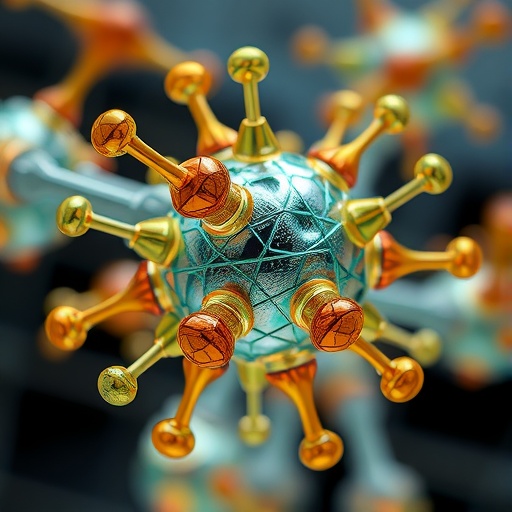In a groundbreaking advancement in enzyme engineering, researchers have successfully achieved the complete computational design of Kemp elimination enzymes demonstrating unprecedented efficiency. This scientific feat marks a pivotal milestone in the rational design of biocatalysts, melding cutting-edge computational tools with a profound understanding of protein structure and dynamics, offering new horizons in synthetic biology and green chemistry.
At the heart of the study lies the ambitious goal of crafting enzymes capable of catalyzing Kemp elimination reactions—a model reaction of great interest due to its relevance in studying enzyme mechanisms and design strategies. Unlike traditional directed evolution approaches, this work harnesses modular assembly and sophisticated design algorithms to generate entirely new enzymatic backbones, finely tuned active sites, and enhanced catalytic capabilities without reliance on natural enzyme templates.
The initial backbone generation involved an ingenious modular strategy leveraging multiple homologous protein structures. Through precise alignment of five distinct imidazole glycerol-phosphate synthase (IGPS) protein backbones, segments were dissected and recombined at structurally conserved junctions. Computational sequence design refined these chimeric constructs, guided by position-specific scoring matrices to ensure stability and compatibility across fragments, thus generating thousands of candidate backbones tailored for subsequent catalytic modification.
.adsslot_k7DWg8530F{ width:728px !important; height:90px !important; }
@media (max-width:1199px) { .adsslot_k7DWg8530F{ width:468px !important; height:60px !important; } }
@media (max-width:767px) { .adsslot_k7DWg8530F{ width:320px !important; height:50px !important; } }
ADVERTISEMENT
Engineering the catalytic site itself was meticulously executed through theozyme modeling. By incorporating precise geometric constraints derived from quantum chemical calculations, the team employed Rosetta’s Matcher algorithm to embed catalytic residues within the designed scaffolds, optimizing their positioning to mimic transition states effectively. This level of geometrical rigor ensured that the catalytic apparatus would be primed for the Kemp elimination’s mechanistic demands.
Once the initial active sites were integrated, the designed enzymes underwent an exhaustive round of sequence optimization focused on the microenvironment surrounding the ligand and catalytic residues. Utilizing Rosetta’s sequence design within spatial proximity to the active site and leveraging mutational scanning data, the design process strategically narrowed the sequence landscape. A ‘fuzzy’-logic objective function balanced energy considerations, van der Waals interactions, solvation effects, and geometric fidelity, filtering millions of designs to identify promising candidates.
Protein expression protocols were developed with precision to ensure that the computationally designed enzymes could be produced reliably and at scale. Harnessing bacterial expression systems and affinity purification techniques, the team prepared high-purity samples essential for detailed biochemical characterization and crystallographic analysis, confirming the fidelity of designs from sequence to structure.
Activity assays monitored enzymatic function using spectrophotometric methods detecting product formation, enabling kinetic parameter determination under varying substrate concentrations. The data fitting to Michaelis-Menten kinetics provided insights into catalytic turnover rates and substrate affinity, highlighting the practical effectiveness of the computationally designed enzymes compared to natural counterparts.
Thermal stability assessments using nano differential scanning fluorimetry revealed the robustness of the new enzymes, a critical factor for potential industrial or therapeutic applications. The temperature ramping experiments showcased the engineered proteins’ ability to maintain structural integrity under stress, consistent with the stability enhancements incorporated during design.
Crystallographic studies offered definitive structural validation, with multiple enzyme variants crystallized and their structures solved to resolutions near or below 2.1 Å. These analyses verified the accuracy of the computational models and provided atomic-level insights into active-site architecture, substrate positioning, and dynamic features instrumental for catalysis.
To complement static structural data, extensive molecular dynamics simulations spanning multiple microseconds illuminated the enzymes’ dynamic behaviors in bound and unbound states. Employing enhanced sampling techniques and state-of-the-art force fields, these simulations elucidated substrate binding modes, active-site flexibility, and solvent interactions, painting a comprehensive picture of the catalytic process in motion.
Electrostatic Valence Bond (EVB) simulations further probed the reaction mechanism at a quantum-mechanical/molecular-mechanical interface, distinguishing between reactive substrate conformers and capturing transient states of the Kemp elimination process. These simulations offered quantitative free-energy profiles that correlated closely with experimental activity, underpinning the rationale behind the designed enzymes’ functionality.
Collectively, this multidisciplinary approach—spanning computational modeling, structural biology, biophysical characterization, and dynamic simulations—presents a paradigm shift in enzyme design. The researchers’ ability to computationally generate highly efficient Kemp eliminases from scratch portends transformative impacts on enzyme engineering, enabling custom biocatalysts for diverse chemical transformations without exhaustive laboratory evolution.
By harnessing sophisticated algorithms, thorough validation pipelines, and rigorous biochemical assays, the study sets a new standard for the scope and precision of computer-aided enzyme design. This breakthrough holds promise not only for academic exploration but also for practical applications in sustainable manufacturing, drug development, and synthetic biology, where tailored catalysts can accelerate innovation and reduce environmental impact.
The confluence of modular backbone assembly, advanced design algorithms, and comprehensive dynamic simulations represents a masterclass in modern enzymology, painting a hopeful future where enzyme engineering is limited only by imagination and computational power. This work invites further refinement and expansion, including exploration of other challenging reactions and incorporation of allosteric regulation, ushering in an era of bespoke enzymes crafted entirely by computation.
Subject of Research: Computational design and engineering of high-efficiency Kemp elimination enzymes.
Article Title: Complete computational design of high-efficiency Kemp elimination enzymes.
Article References:
Listov, D., Vos, E., Hoffka, G. et al. Complete computational design of high-efficiency Kemp elimination enzymes. Nature (2025). https://doi.org/10.1038/s41586-025-09136-2
Image Credits: AI Generated
Tags: biocatalyst engineeringcatalytic activity enhancementchimeric enzyme constructscomputational enzyme designdirected evolution alternativesenzyme mechanism studygreen chemistry innovationshigh-efficiency Kemp eliminasesmodular protein assemblyprotein structure dynamicsrational enzyme design strategiessynthetic biology advancements





